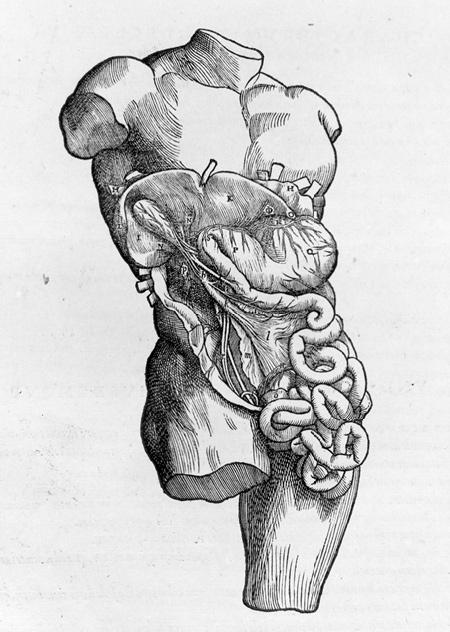 Vesalius
VesaliusDIGESTIVE SYSTEM
 Vesalius
Vesalius
I Overview
A. Muscular tube
B. Function: digestion and absorption
II Gastrointestinal tract: basic design (4 tunics)
A. mucosa
1. epithelium
2. lamina propria
3. muscularis mucosa
B. submucosa
1. submucosal plexus
C. muscularis externa
1. circular muscle
2. myenteric plexus
a. enteric neurons
b. parasympathetic and sympathetic modification
3. longitudinal muscle
D. serosa (visceral peritoneum)
III Gastrointestinal tract: regional specializations
A. Mouth
1. teeth: mechanical digestion (chewing)
2. salivary glands (3): chemical digestion (salivary amylase for starches)
B. Esophagus
1. peristalsis
2. gastroesophageal sphincter
C. Stomach
1. structure and regions
2. tunic modifications
a. mucosa - gastric glands
1. chemical digestion: pepsin (for protein)
b. muscularis externa - triple-layered
1. mechanical digestion: production of chyme
D. Small intestine
1. structure and regions
2. chemical digestion
a. intestinal enzymes
b. enzymes from pancreas
c. bile from liver
3. mechanical digestion: segmentation
4. absorption: tunic modifications
a. mucosa and submucosa - foldings
1. plica circulares --> villi --> microvilli
E. Large intestine
1. structure and regions
2. tunic modifications
a. muscularis externa: taeniae coli
3. functions: reabsorption of water and fecal storage
IV Accessory Organs
A. Liver
1. structure
2. functions
3. digestive function
a. bile
B. Gall bladder
1. storage of bile
2. gall stones
C. Pancreas
1. structure
2. functions
a. enzymes
b. bicarbonate
c. hormones
At the end of this unit you should be able to:
- distinguish between digestion and absorption
- distinguish between mechanical and chemical digestion
- identify the six major regions of the digestive tube
- locate and describe each of the four tunics (layers) of the wall of the digestive tube
- compare the submucosal plexus and myenteric plexus of the GI tract wall
- describe the types of digestion that occur in the mouth
- locate and distinguish between pharynx, larynx, and esophagus
- explain gastro-esophageal "acid reflux"
- identify the regions of the stomach and modifications in the tunics of the stomach wall
- discuss the chemical and mechanical digestion in the stomach
- locate the three major regions of the small intestine
- identify the three accessory organs (liver, gall bladder, pancreas) which add digestive juices to the duodenum
- trace pathway of bile from production to duodenum
- trace pathway of pancreatic enzymes from production site to duodenum
- explain how the liver, gall bladder, and pancreas assist digestion
- discuss the chemical digestion that occurs in the duodenum
- locate and describe the crypts of Lieberkuhn
- compare peristalsis and segmentation
- identify and compare the structures of the small intestine wall (plica circulares, villi, microvilli, lacteal)
- explain how the structures of the small intestine wall are related to the function of the wall.
- identify the structures at the junction of the small and large intestine
- locate the regions of the large intestine
- define haustra and taenia coli
- explain the function of the large intestine
return to Anatomy Outlines
return to Human Anatomy
return to Home page